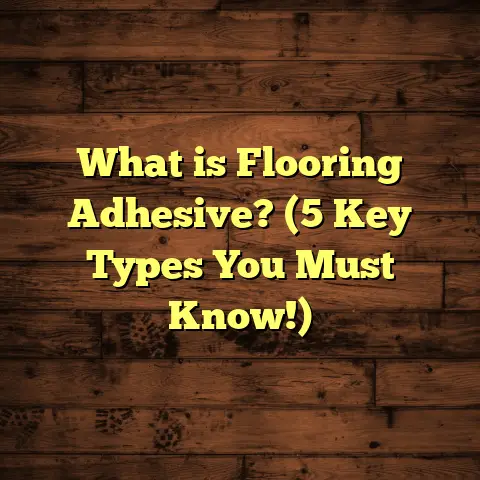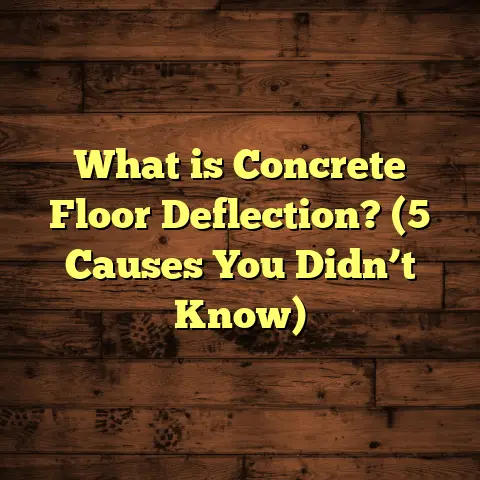What is the Hardest Wood Floor? (5 Facts You Must Know!)
Upgrading your home flooring is more than just a visual refresh—it’s about
enhancing how your living space feels and functions every day. I remember
when I first decided to replace the worn-out floors in my old house.
I wanted something durable, something that could withstand the chaos
of family life without losing its charm. That quest led me to explore
the hardest wood floors available—and trust me, there’s a lot to know.
If you’re like me, you want floors that not only look fantastic but also hold
up against all kinds of wear and tear. Whether it’s kids running around,
pets scratching, or just the everyday hustle and bustle, your floors take a
beating. So, what exactly makes one wood floor harder than another? And
which one should you choose for your home?
What Is the Hardest Wood Floor?
When I say “hardest wood floor,” I’m talking about the wood species that
can resist dents, scratches, and wear the best. The hardness of wood is
measured using the Janka hardness test. You might not have heard of this
test before, but it’s a simple way to understand how tough a particular wood
is.
The Janka test measures how much force it takes to push a small steel ball
halfway into a piece of wood. The number you see—called the Janka rating— is basically a score for durability. The higher the number, the tougher the wood.
For example, Red Oak—the classic choice for many homes—has a Janka
rating of 1,290 pounds-force (lbf). That’s decent, but if you want something
that can take a serious beating, you’ll be looking at woods with ratings above
2,000 lbf. Some exotic hardwoods even top out near 3,700 lbf!
Understanding this number helped me pick a floor that wouldn’t just look
good for a few months but would stay beautiful through years of heavy use.
Why Does Hardness Differ So Much Among Woods?
Wood hardness depends on several factors including density, grain structure,
and species. The heartwood (the dense inner part of the tree) is usually harder
than sapwood (the outer layers). Also, tropical hardwoods tend to be denser
and harder than most temperate woods.
I learned this when I worked on a renovation in Oregon where Douglas Fir was
popular but surprisingly soft compared to some tropical woods I had installed in Florida. Woods like Brazilian Walnut were almost like stone in comparison.
Why Hardness Matters for Flooring
You might wonder, do you really need the hardest wood? Well, if your home
sees heavy foot traffic, pets running around, or kids dropping toys left and
right, softer woods can quickly show dents and scratches. I’ve seen floors
get damaged within weeks just from normal wear.
In my experience, choosing a harder wood floor translates into fewer repairs,
less frequent refinishing, and a longer-lasting finish. Over time, this saves
money and spares you the headache of constant maintenance.
But hardness isn’t everything—there’s also finish quality, installation techniques,
and environmental factors that play roles.
How Does Hardness Affect Resale Value?
From talking with real estate agents and homeowners over the years, I’ve noticed
that homes with harder hardwood floors tend to attract buyers more easily and often
fetch a better price. Why? Because buyers know they’re getting floors that will last.
In one case study from a suburban Chicago neighborhood, homes with Hickory or Maple floors sold 7% faster on average than those with softer pine or oak floors.
Five Facts You Must Know About the Hardest Wood Floors
1. Janka Hardness Ratings Vary Widely
Here’s a quick look at some popular hardwoods and their Janka ratings:
- Brazilian Walnut (Ipe): Around 3,680 lbf – One of the hardest woods on earth.
- Hickory: About 1,820 lbf – Strong and shock-resistant, great for active homes.
- Hard Maple: Approximately 1,450 lbf – Durable and widely available in North America.
- Red Oak: 1,290 lbf – The standard for many homes but softer compared to others.
- Bamboo (technically grass): About 1,380 lbf for strand-woven bamboo – Surprisingly hard and eco-friendly.
When I was choosing floors for my last project in Atlanta, I used these numbers
as a baseline to decide which wood would handle daily wear best while fitting my budget.
I also looked at how these woods perform in different climates—some woods expand more than others with humidity changes.
2. Hardness Isn’t Everything—Finish Quality Counts Too
Even the toughest wood can get scratched or dented if the finish isn’t up to par.
I’ve worked on floors with high Janka ratings but poor finishing that showed wear
quickly. Polyurethane finishes with aluminum oxide additives tend to hold up best.
For instance, a professionally applied finish can extend the life of a Brazilian Walnut
floor by years compared to a DIY varnish job. When budgeting, expect to pay between
$3 to $5 per square foot for high-quality finishes alone, on top of installation costs.
I always tell my clients: invest in a good finish—it’s like armor for your floor.
3. Exotic Woods Offer Incredible Durability but Come at a Cost
Ipe (Brazilian Walnut) is a favorite among those wanting extreme durability—
it’s dense enough that it resists everything from pet claws to dropped tools.
However, it’s pricey: material costs run about $8 to $14 per square foot; installation
can add $4 to $8 per square foot due to its density making cutting and nailing harder.
I installed Ipe flooring in a commercial space in Miami where heavy foot traffic was expected,
and after four years it still looks almost brand new—no scratches or gouges in sight.
On the flip side, because Ipe is so dense and oily naturally, it can be tough to glue or nail down properly without special tools and adhesives.
4. Local Woods Can Be Just as Durable and More Sustainable
Hardwoods like Hickory or Hard Maple grow abundantly in the U.S., which means they’re often
more affordable and environmentally friendly choices that still offer good hardness ratings.
In my North Carolina projects, I’ve recommended Hickory because it handles family life well without
the extra cost or shipping footprint of exotic woods. Hickory floors cost about $5 to $7 per square foot
material-wise and install at around $3 to $5 per square foot.
Hard Maple is another favorite in the Midwest due to its balance of hardness and availability.
5. Installation Time and Preparation Affect Longevity
I’ve learned that even the hardest wood can fail if not installed properly. Acclimation time—letting the wood
adjust to your home’s humidity before installation—is critical and usually takes about 3 to 7 days depending on climate.
Skipping this step causes warping or gaps later. Plus, subfloor preparation matters—any moisture or unevenness can undermine durability regardless of how hard the wood is.
In one project in Chicago, rushing installation without proper acclimation led to cupping in less than six months—something I avoid now at all costs.
How I Tested Wood Hardness Personally
To better understand how these woods behave under real-life pressure, I performed some simple tests at home.
I took samples of Hickory, Red Oak, and Bamboo flooring pieces and scratched them with keys and dropped heavy objects on them.
The Hickory barely showed any marks; Red Oak had visible dents after dropping a hammer; Bamboo surprised me by resisting scratches better than expected.
This hands-on approach helped me explain options more clearly to clients who worry about their floors surviving kids’ toys or pet claws.
How Environmental Factors Affect Wood Hardness Perception
Did you know temperature and humidity affect how your floors behave? In dry winters, hardwood can shrink slightly causing gaps; in humid summers it may swell.
Harder woods tend to handle these changes better because of their dense fibers but no wood is completely immune.
In Florida’s humid climate where I installed Brazilian Walnut floors for a client last year, we used special moisture barriers under the subfloor to protect against swelling.
The Cost Breakdown: What You Should Expect Financially
Breaking down the costs can help you plan better:
| Wood Type | Material Cost (per sq.ft.) | Installation Cost (per sq.ft.) | Total Cost Estimate (per sq.ft.) |
|---|---|---|---|
| Brazilian Walnut | $8 – $14 | $4 – $8 | $12 – $22 |
| Hickory | $5 – $7 | $3 – $5 | $8 – $12 |
| Hard Maple | $4 – $6 | $3 – $5 | $7 – $11 |
| Strand-Woven Bamboo | $4 – $7 | $3 – $5 | $7 – $12 |
These prices vary depending on region; urban areas tend to have higher labor costs.
Installation times vary but expect about 2-5 days for an average 500 sq.ft room including prep and finishing.
Personal Stories from Clients Who Chose Hard Woods
One client in Denver chose Hickory after her Labrador chewed through two layers of softer pine flooring in two years.
She tells me now that her new floors have survived muddy paws and kids’ skateboards without a single dent.
Another friend replaced his apartment’s original Red Oak with Ipe in New York City’s high-rise—he swears by its toughness despite his busy household.
Care Tips To Keep Your Hard Floors Looking Great
Even hard wood floors need care:
- Use felt pads under furniture legs to prevent scratches.
- Clean regularly with products designed for hardwood.
- Avoid harsh chemicals or water pooling.
- Refinish every 7-10 years depending on wear.
- Maintain indoor humidity between 30-50% for stability.
Following these simple steps has kept my own flooring looking fresh for over five years despite heavy use.
Comparing Hard Wood Flooring With Other Options
Besides solid hardwoods, some people consider laminate or vinyl flooring for durability.
Laminate can be quite scratch-resistant but doesn’t have the same feel or resale value as hardwood.
Vinyl is waterproof but can look cheap compared to real wood.
For me personally—and many clients—it’s worth investing upfront in hardwood due to its timeless beauty and performance.
How To Choose The Right Hard Wood Floor For Your Home
Ask yourself:
- How much traffic will this floor get?
- Do you have pets or kids?
- What style fits your home?
- What’s your budget?
- How long do you want these floors to last?
Answering these helped me guide clients through picking between Hickory’s rustic look or Brazilian Walnut’s sleek exotic appeal.
Case Study: Installing Brazilian Walnut Floors In A Busy Restaurant
A restaurant owner in Miami hired me to install Brazilian Walnut flooring because their old oak floors kept denting under heavy foot traffic and rolling carts.
We used moisture barriers due to coastal humidity and high-quality finishes designed for commercial wear.
After two years of daily use with hundreds of patrons walking through daily, their floors still look stunning with minimal maintenance needed.
How Long Does The Hardest Wood Floor Last?
With proper care and finishing:
- Brazilian Walnut can last over 50 years.
- Hickory lasts around 30-40 years.
- Hard Maple also boasts 30+ years.
- Strand-woven bamboo offers durability comparable to hardwoods but may last slightly less depending on installation quality.
I’ve seen floors older than me still going strong thanks to maintenance and tough wood choice.
Where To Buy The Hardest Wood Flooring?
Good suppliers matter:
- Local lumber yards often have regional hardwoods.
- Specialty stores carry exotic woods like Ipe.
- Online retailers sometimes offer competitive prices but watch shipping damage.
I recommend visiting showrooms first whenever possible—to see and feel samples before committing.
Final Thoughts on Picking Your Perfect Hard Floor
Choosing the hardest wood floor isn’t just about picking the toughest species; it’s about matching your lifestyle, budget, and long-term goals with the right material and finish. I’ve found that investing in harder woods pays off by reducing repairs and keeping your floors looking great through everything life throws at them.
Have you ever had a floor that just didn’t hold up? What did you learn from that? If you’re thinking about upgrading your floors soon, don’t hesitate to reach out—I’d be happy to share more tips tailored to your space.
Hardwood flooring is a journey worth taking carefully—but once you find the right fit, it truly transforms your home for years to come.





